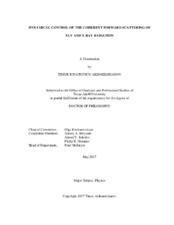| dc.contributor.advisor | Kocharovskaya, Olga | |
| dc.creator | Akhmedzhanov, Timur Rinatovich | |
| dc.date.accessioned | 2017-08-21T14:35:20Z | |
| dc.date.available | 2019-05-01T06:07:45Z | |
| dc.date.created | 2017-05 | |
| dc.date.issued | 2017-02-27 | |
| dc.date.submitted | May 2017 | |
| dc.identifier.uri | https://hdl.handle.net/1969.1/161354 | |
| dc.description.abstract | This work aims at development of new dynamical methods to control a resonant light-matter interaction as well as at their application for producing new sources of coherent intense sub-fs radiation in x-ray range. The dynamical control is based on modulation in time and in space of the parameters of the atomic transition (coupled to the resonant high-frequency field) by means of sufficiently strong off-resonant low-frequency control field. In particular, it may result in efficient transfer of quasi-monochromatic VUV or XUV radiation into ultrashort pulses via its resonant interaction with atomic hydrogen gas or plasma of hydrogen-like ions respectively by means of two different techniques: time and space dependent linear Stark effect or interruption of resonant interaction by the tunneling ionization, as shown in previous works of our group.
In this thesis, I further develop these ideas and demonstrate their important potential applications. First of all, both techniques are extended to arbitrary (non-hydrogen-like) atomic medium. Furthermore, advanced analytical and numerical solutions describing a process of pulses formation are found and shown to be in excellent agreement with each other. A deep physical analogy between the processes of coherent forward scattering of γ-ray radiation in the vibrated quasi-resonant nuclear absorber and the XUV field propagation in the quasi-resonant atomic medium in the presence of the moderately strong IR field is established.
Finally, the application of the developed techniques for production of intense coherent attosecond sources of soft X-ray radiation, including so-called “water window” range (2.2-4.3nm) (especially promising for dynamical imaging of the proteins in a living cell) is proposed. Two different paths towards production of intense coherent attosecond pulses in a soft X-ray range are suggested: (i) via efficient transformation of the picosecond radiation of the high energy pulses of the existing x-ray plasma lasers into the trains of attosecond pulses in the resonant passive plasma, and (ii) via amplification of the low energy pulses of the existing high harmonic sources in the resonant active plasma of x-ray lasers. | en |
| dc.format.mimetype | application/pdf | |
| dc.language.iso | en | |
| dc.subject | ultrashort pulses | en |
| dc.subject | attosecond pulses | en |
| dc.title | Dynamical Control of the Coherent Forward Scattering of XUV and X-Ray Radiation | en |
| dc.type | Thesis | en |
| thesis.degree.department | Physics and Astronomy | en |
| thesis.degree.discipline | Physics | en |
| thesis.degree.grantor | Texas A & M University | en |
| thesis.degree.name | Doctor of Philosophy | en |
| thesis.degree.level | Doctoral | en |
| dc.contributor.committeeMember | Belyanin, Alexey A | |
| dc.contributor.committeeMember | Sokolov, Alexei V | |
| dc.contributor.committeeMember | Hemmer, Philip R | |
| dc.type.material | text | en |
| dc.date.updated | 2017-08-21T14:35:20Z | |
| local.embargo.terms | 2019-05-01 | |
| local.etdauthor.orcid | 0000-0002-2671-0372 | |


